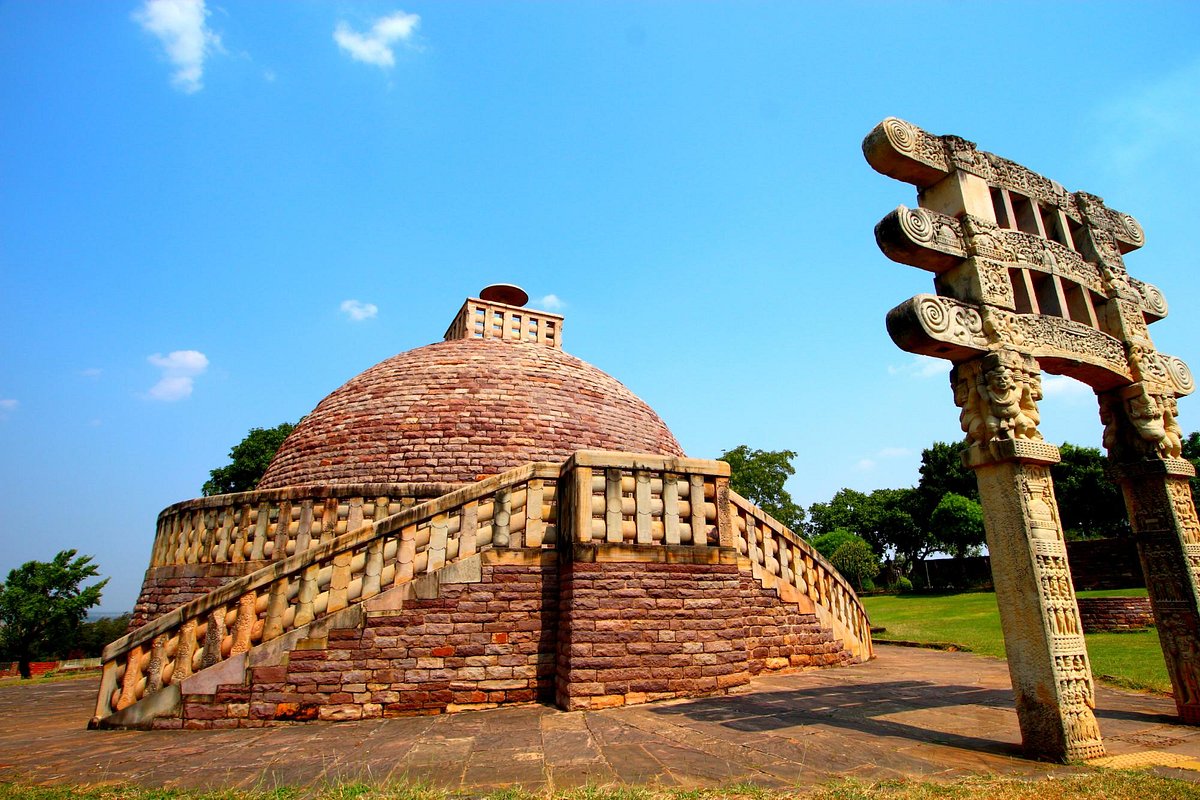Buddhist Monuments at Sanchi
It was the Indian emperor Ashoka’s embrace of Buddhism in the 3rd century BC that turned it into one of the world’s major religions. Here at Sanchi, you can see the greatest tribute he built to his new faith – an enormous stupa containing relics of Buddha himself. The intricate carved stone artworks telling historical stories help make the Great Stupa of Sanchi one of the marvels of the ancient world.
 Without Emperor Ashoka, Buddhism would possibly never have had such a dramatic impact around the world. In the 3rd century BC, the Indian ruler embraced the new religion and spread it across his vast territory. He saw it as a way to bring peace to his people, but his decision had much more far-reaching consequences. It gave momentum and authority to a religious movement that would spread to every corner of the globe over the next two millennia.
About 400 years after Buddha was born in Lumbini, the Buddhist faith was being practiced by a relatively small group of followers in the Ganges valley, who had split into various schools. Emperor Ashoka was drawn to the teachings of Buddha that they spread, particularly those of social justice.
Historical sources tell us that Ashoka had been left traumatised by the huge death toll of a war he had waged. In Buddhism, he saw a new path where he could conquer minds and hearts with morality rather than weapons. He believed that if all of his subjects followed this same peaceful religion, he could end conflict across his lands.
To help spread his message around the Indian subcontinent, Ashoka erected stupas and other monuments with inscriptions. Over the centuries, most have been badly damaged or destroyed – although some still exist. The Great Stupa at Sanchi stands out as not just the best preserved of them all, but also the most beautiful. It is not just a testament to Ashoka’s story, but is still worshipped today as an incredible piece of ancient art.
The Great Stupa at Sanchi sits at the top of a peaceful hill, easily seen from the surrounding areas without overshadowing the landscape. It’s located about 10 kilometres from the city of Vidisha, which was a wealthy trading city at the time of the stupa’s construction. Probably more importantly, though, Vidisha is also said to be the hometown of a woman that Ashoka fell in love with. She couldn’t follow him back to the capital to be his queen and it’s believed that influenced his decision to build his tribute in this location.
The Great Stupa’s dome is more than 16 metres high and 36 metres in diameter (having been expanded over the centuries). Aside from its size, one of the first things that strikes you when you arrive is the detailed rock carvings that adorn the gateways at the four cardinal points. These were added after the death of Emperor Ashoka and show intricate scenes, including from the life of Buddha and the history of Buddhism.
Around the Great Stupa are smaller stupas, as well as the remains of later temples and monasteries. After Emperor Ashoka built his monument here in the 3rd century BC, this became an important place of worship for many centuries to come. You can see here the evidence of Buddhist activity here until at least the 12th century AD.
Further afield, there are other important Buddhist monuments that are easily reachable from Sanchi, including the impressive stupas at Satdhara and Sonari. The area continued to be an important centre for trade and faith, even as the dominance of different religions rose and fell.
As you travel in the region around Sanchi and the city of Bhopal, you will find other significant sites with stunning works of art. There are also the artworks left on rock faces from people who lived here thousands of years before Buddha was born or Ashoka embraced his message and spread it to the world.
Without Emperor Ashoka, Buddhism would possibly never have had such a dramatic impact around the world. In the 3rd century BC, the Indian ruler embraced the new religion and spread it across his vast territory. He saw it as a way to bring peace to his people, but his decision had much more far-reaching consequences. It gave momentum and authority to a religious movement that would spread to every corner of the globe over the next two millennia.
About 400 years after Buddha was born in Lumbini, the Buddhist faith was being practiced by a relatively small group of followers in the Ganges valley, who had split into various schools. Emperor Ashoka was drawn to the teachings of Buddha that they spread, particularly those of social justice.
Historical sources tell us that Ashoka had been left traumatised by the huge death toll of a war he had waged. In Buddhism, he saw a new path where he could conquer minds and hearts with morality rather than weapons. He believed that if all of his subjects followed this same peaceful religion, he could end conflict across his lands.
To help spread his message around the Indian subcontinent, Ashoka erected stupas and other monuments with inscriptions. Over the centuries, most have been badly damaged or destroyed – although some still exist. The Great Stupa at Sanchi stands out as not just the best preserved of them all, but also the most beautiful. It is not just a testament to Ashoka’s story, but is still worshipped today as an incredible piece of ancient art.
The Great Stupa at Sanchi sits at the top of a peaceful hill, easily seen from the surrounding areas without overshadowing the landscape. It’s located about 10 kilometres from the city of Vidisha, which was a wealthy trading city at the time of the stupa’s construction. Probably more importantly, though, Vidisha is also said to be the hometown of a woman that Ashoka fell in love with. She couldn’t follow him back to the capital to be his queen and it’s believed that influenced his decision to build his tribute in this location.
The Great Stupa’s dome is more than 16 metres high and 36 metres in diameter (having been expanded over the centuries). Aside from its size, one of the first things that strikes you when you arrive is the detailed rock carvings that adorn the gateways at the four cardinal points. These were added after the death of Emperor Ashoka and show intricate scenes, including from the life of Buddha and the history of Buddhism.
Around the Great Stupa are smaller stupas, as well as the remains of later temples and monasteries. After Emperor Ashoka built his monument here in the 3rd century BC, this became an important place of worship for many centuries to come. You can see here the evidence of Buddhist activity here until at least the 12th century AD.
Further afield, there are other important Buddhist monuments that are easily reachable from Sanchi, including the impressive stupas at Satdhara and Sonari. The area continued to be an important centre for trade and faith, even as the dominance of different religions rose and fell.
As you travel in the region around Sanchi and the city of Bhopal, you will find other significant sites with stunning works of art. There are also the artworks left on rock faces from people who lived here thousands of years before Buddha was born or Ashoka embraced his message and spread it to the world.
The artwork of Sanchi
The four gateways to the Great Stupa are famed for the beauty of their intricate carvings – and knowing what they represent offers a deeper understanding of the Sanchi site. The gateways, or ‘toranas’, were built in the 1st century BC and were sponsored by different lay worshippers. Each was carved by various craftspeople at different times, giving them slightly varied styles. Each of the gateways has two square pillars with a set of four lions, elephants, or pot-bellied dwarves supporting a large grid with three architraves. Between the architraves are figures of horsemen and elephants. But it’s the architraves themselves that offer us the most, with incredibly-detailed scenes carved into the rock. The southern gateway shows an image of the Stupa of Ramagrama near Lumbini, the only one of the stupas with original relics of Buddha that Emperor Ashoka did not open. It also shows scenes from the Siege of Kushinagar and the story of Chhaddanta Jataka, a previous incarnation of Buddha. The western gateway also shows a scene from the Siege of Kushinagar and another part of the story of Chhaddanta Jataka. It also has carvings depicting Buddha’s first sermon and his enlightenment. Moving around to the northern gateway, there are scenes showing different incarnations of Buddha, including a continuation of the story of Chhaddanta Jataka. There is also a depiction of an event leading up to his enlightenment, when Sujata offered him food. At the eastern gateway, you can see images of Buddha leaving his home at Kapilavastu to begin his journey to enlightenment. Importantly, there is also a scene of Emperor Ashoka visiting the Bodhi tree where the enlightenment occurred. This carving, coming at least a hundred years after the Great Stupa was built, is an important tribute to both Buddha and the man who so passionately embraced his teachings.Buddhism around Sanchi
The stupas and monasteries at Sanchi created a thriving Buddhist community of monks and supporters. As more people came over the centuries, other settlements were founded nearby, and the region became a hub of spiritual activity. One of the most important settlements was at Satdhara, about 17 kilometres from Sanchi. There would once have been about 30 stupas and three monasteries here and, at its peak, Satdhara would have been home to about 100 monks. While the main stupa was probably originally constructed during Ashoka’s rule, the rest of the site would have been built later. You can see evidence of other stupas and settlements at nearby sites like Sonari, Andher and Murelkhurd. They show that the immediate effects of Emperor Ashoka’s embrace of Buddhism were more than just ceremonial. He inspired many of his people to begin living their lives according to the teachings of the Buddha.The flow of faith
Although Emperor Ashoka achieved his aim of making Buddhism the dominant religion in the region, it did not last forever. By the 13th century AD, the community at Sanchi had been virtually abandoned and many of the monuments were falling into disrepair. It was not until the 19th century that the site would be rediscovered by those with an interest in restoring it. Meanwhile, the growing Hindu community was founding its own centres of faith in the region, many of which are still covered with beautiful artwork. Jain worship sites were also set up at around the same time. Later, the Mughal Empire brought Islam to the region and mosques were built afresh or created by modifying existing temples. Some of the most important sites of all these religions have been preserved and offer visitors a chance to see the development of faith in the region around Sanchi in the millennia following its foundation. The places of worship are not just visually beautiful, they are also entwined with deep historical and cultural stories. Emperor Ashoka’s legacy is not measured purely by the spread of Buddhism around the world and its strength today. He also nurtured an artistic and spiritual environment around Sanchi that has evolved over many centuries and left us with a rich collection of historical treasures.Trips
& tours
Choose M.P Holidays®
- Approved by “The Ministry of Tourism” (Approval No: 2203270HE874)
- “The Official No.1 Channel Partner” of M.P Tourism (Registration No: MP-TOUR-20221/131888)
- We are Awarded “The Best Travel Agent” by M.P. Government for the three consecutive years. (2016, 2017 and 2018)
- Having offices at
- Surat
- Indore
- Ahmedabad
- Pachmarhi
- Nagpur
- Kanha
- Discover Madhya Pradesh from major cities like Surat, Ahmedabad, Delhi, Mumbai, Nagpur, Pune and beyond—experience the best of India, no matter where you start.
- Own resort at Madhya Pradesh.






